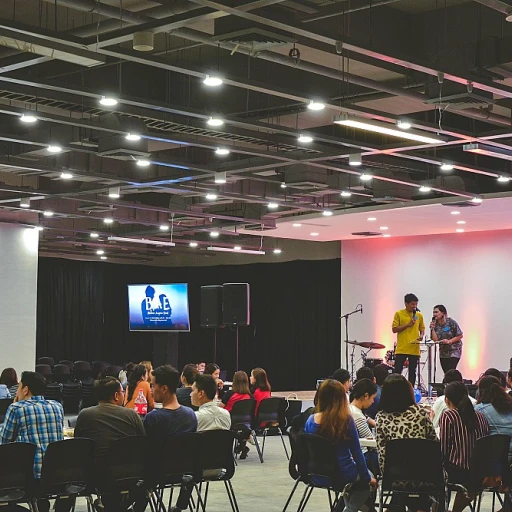
Understanding Employee Experience Platforms
Exploring Platforms for a Seamless Workplace Experience
Understanding the landscape of employee experience platforms is essential for enhancing employee satisfaction and optimizing business operations. These platforms serve not just as administrative tools but as comprehensive solutions that aim to improve how employees interact with their work environment. The overarching goal is to foster an enriched and connected workplace that aligns with the employer's branding strategy. In today's digital age, employers are increasingly adopting platforms that integrate various functions: from payroll management to employee service access. These tools are essential not only for managing employees effectively but also for offering insights into how various functions vary depending on the specific needs of the organization. Employees can, for instance, view and manage their time records, access their pay slips, and set up direct deposits through intuitive mobile app interfaces. This integration supports a more seamless login experience, which directly impacts overall employee satisfaction. Moreover, employee experience platforms facilitate privacy policy adherence while simultaneously offering benefits administration that’s easy to navigate for the employees. By connecting through these platforms, employers ensure that employees have ready access to crucial services such as retirement benefits and performance management, which can also be tailored to stay aligned with the employer’s policies and privacy norms. The benefits of these platforms are manifold. They not only help businesses streamline their processes but also provide employees with the necessary tools to manage their employment effectively. This, in turn, enhances the overall employee experience, contributing to a more positive employer brand image in the eyes of current and prospective employees. For a deeper dive into navigating health and wellness challenges as part of improving your brand, check out our insights on wellness challenges. Thus, these platforms are not just about facilitating employee access—they are instrumental in building a cohesive, supportive, and future-ready workplace.The Role of Seamless Login in Employee Satisfaction
Seamless Login: A Cornerstone of Employee Satisfaction
In today's fast-paced business environment, ensuring a seamless login experience is crucial for enhancing employee satisfaction. Employers are increasingly recognizing that the ease with which employees can access their work tools directly impacts their overall experience. By simplifying the login process, businesses can help employees stay connected and focused on their tasks, rather than being bogged down by technical hurdles.
Seamless access to employee experience platforms is not just about convenience; it’s about empowering employees to manage their time and resources effectively. With features like direct deposit, payroll management, and benefits administration integrated into a single platform, employees can view and manage their data effortlessly. This integration supports a more efficient workflow, allowing employees to focus on performance management and other critical tasks.
Mobile Access and Employee Services
The rise of mobile apps has further transformed how employees interact with their workplace tools. An employee service app available on the app store can provide instant access to essential functions, such as setting direct deposits or accessing pay information. This mobility ensures that employees can manage their work-life balance more effectively, accessing necessary services anytime, anywhere.
Moreover, the privacy policy and security measures associated with these platforms are paramount. Employers must ensure that the data privacy of their employees is maintained, fostering trust and reliability in the systems provided. The features offered by these platforms can vary depending on the employer's chosen solutions, but the goal remains the same: to enhance the employee experience through seamless access and support.
Trends in Employer Branding and Technology Integration
Integrating Modern Technology into the Workplace
The landscape of employer branding is significantly shaped by how businesses leverage technology to enhance their employee experience. In today's digital era, organizations are increasingly focusing on implementing platforms that support seamless access to various services. This focus not only increases employee satisfaction but also strengthens the overall employer brand.
One of the key areas where technology is making a profound impact is in simplifying and enhancing login experiences. Seamless login solutions are becoming a vital part of employee service platforms. These solutions allow employees to access pay information, manage direct deposits, and view benefits with ease, thus improving their overall experience. A streamlined login process can also support valuable functions like payroll management and benefits administration, enhancing the employee's day-to-day work environment.
Employers are constantly seeking new ways to integrate technology to stay connected with their workforce. Mobile apps are playing a crucial role in this effort. Employees can now access important services via app stores, offering them the flexibility to manage their time, pay, and even retirement plans through user-friendly employee experience apps. These tools help manage employees more effectively by providing crucial insights into performance management and benefits usage.
Privacy policies are also coming to the forefront, as employers integrate newer technologies. Companies must ensure that their technology solutions respect employee privacy and data security, building trust and authority in their employer brand. By carefully choosing and varying the features and functions depending on the organization's specific needs, businesses can craft a tailored experience that resonates well with their employees.
The integration of technology into employer branding efforts is not a one-size-fits-all solution. The features employers choose will vary depending on their unique business needs and the specific functions they wish to support. To explore further insights and trends, including how enhancing employee benefits can bolster a stronger employer brand, consider visiting this comprehensive guide.
Challenges in Implementing Seamless Access
Overcoming Barriers to Seamless Access
Implementing seamless access in employee experience platforms is not without its challenges. Businesses often encounter hurdles that can impede the smooth integration of login and access systems, which are crucial for enhancing employee satisfaction. These challenges can range from technical issues to organizational resistance.
Technical Complexities
One of the primary challenges is the technical complexity involved in integrating various systems. Employers need to ensure that their login and access solutions are compatible with existing infrastructure. This includes managing employee data securely while providing easy access to payroll, benefits administration, and performance management tools. The functions of these systems can vary depending on the features chosen by the employer, which can complicate the integration process.
Privacy and Security Concerns
Privacy policy and security are paramount when implementing seamless access. Employers must safeguard sensitive employee information, such as direct deposit details and retirement benefits. Ensuring that mobile apps and employee service platforms adhere to stringent security standards is essential to maintain trust and compliance with regulations.
Organizational Resistance
Another significant challenge is overcoming organizational resistance. Employees and management may be hesitant to adopt new technologies, especially if they perceive them as disruptive. Providing adequate support and training can help ease this transition, allowing employees to view the new systems as beneficial tools that enhance their work experience.
Resource Allocation
Implementing seamless access solutions requires substantial resources, both in terms of time and finances. Employers must carefully manage these resources to ensure successful deployment. This includes setting up direct support channels for employees to address any issues they encounter with the new systems.
Despite these challenges, the benefits of seamless access in enhancing the employee experience are significant. By addressing these barriers, businesses can create a more connected and efficient workplace, ultimately leading to improved employee satisfaction and performance.
Case Studies: Successful Implementations
Case Studies Demonstrating Seamless Access Implementation Success
Employers striving to enhance their branding and employee experience have increasingly turned to seamless access solutions. These solutions are pivotal in reshaping how businesses manage employees' access to necessary tools and benefits. Let’s delve into several case studies that underscore the successful implementation of these initiatives. For one company, integrating a centralized employee experience app led to marked improvements in managing employee data and facilitating payroll tasks. Employees could easily access pay information, set up direct deposits, and view retirement benefits, all from a mobile app. This streamlined access supported a better employee service experience and provided employees with tools to stay connected with their employer chosen benefits. Another example involves a business that faced challenges with login systems, affecting employee satisfaction and service clients. By implementing a unified login solution, the company enhanced the employee experience by enabling seamless access to performance management and benefits administration platforms. The solution’s depending features allowed the company to tailor access according to the role and needs of their employees, proving beneficial in managing employee expectations effectively. In a different sector, a financial services firm realized the advantages of seamless access solutions through the app store provided features. Employees could manage their time and access benefits without the hassle of multiple logins. This move not just empowered employees but also improved the company's image as an employer that values efficiency, privacy, and ease of access. While these successes illustrate various pathways to integrating seamless access solutions, functions vary depending on the specific needs and goals of each employer. As businesses continue to innovate and adapt in their approach to employee experience, these solutions provide critical insights to help manage employee expectations and bolster employer branding effectively.Future Outlook: The Evolution of Employee Experience Platforms
The Future of Employee Experience Platforms
As businesses continue to evolve, so too must the platforms that support their employees. The future of employee experience platforms is set to be shaped by several key trends, each aimed at enhancing the overall experience for employees and employers alike.
Integration of Advanced Technologies
One of the most significant trends is the integration of advanced technologies such as artificial intelligence and machine learning. These technologies will help employers manage employees more effectively by providing insights into employee behavior and preferences. This data-driven approach can lead to more personalized employee services, from payroll management to benefits administration.
Emphasis on Seamless Access
The importance of seamless access cannot be overstated. Future platforms will likely focus on improving login processes and ensuring that employees can access pay, view benefits, and manage their time efficiently through a single, unified app. This will not only enhance employee satisfaction but also streamline operations for businesses.
Mobile-First Solutions
With the rise of remote work, mobile-first solutions are becoming increasingly important. Employers are expected to offer mobile apps that allow employees to stay connected and manage their work-related tasks on the go. These apps will likely be available on major app stores, providing easy access to essential tools and services.
Focus on Privacy and Security
As platforms become more integrated, ensuring the privacy and security of employee data will be paramount. Future solutions will need to adhere to strict privacy policies to protect sensitive information, such as direct deposit details and performance management data.
Customization and Flexibility
Finally, the future of employee experience platforms will likely see a shift towards more customizable and flexible solutions. Employers will be able to choose features that best suit their needs, with functions varying depending on the specific requirements of their business. This flexibility will help employers provide a more tailored experience for their employees, ultimately leading to higher satisfaction and retention rates.













